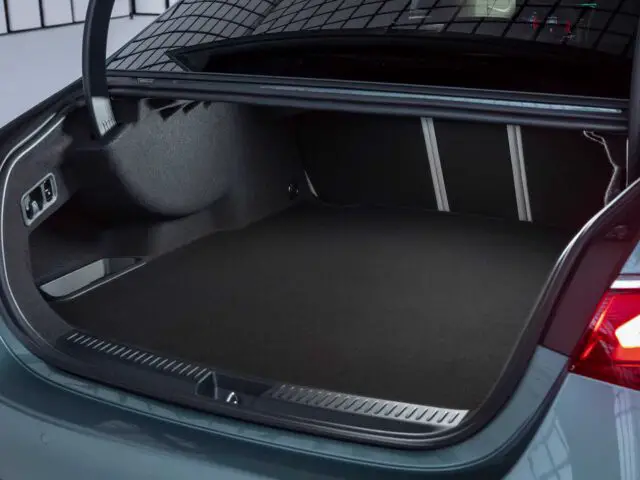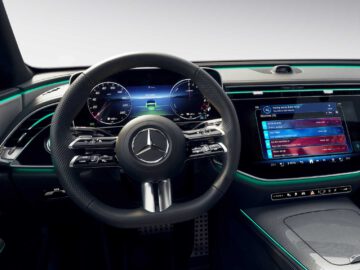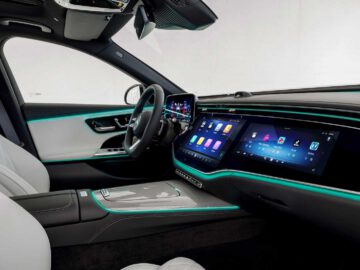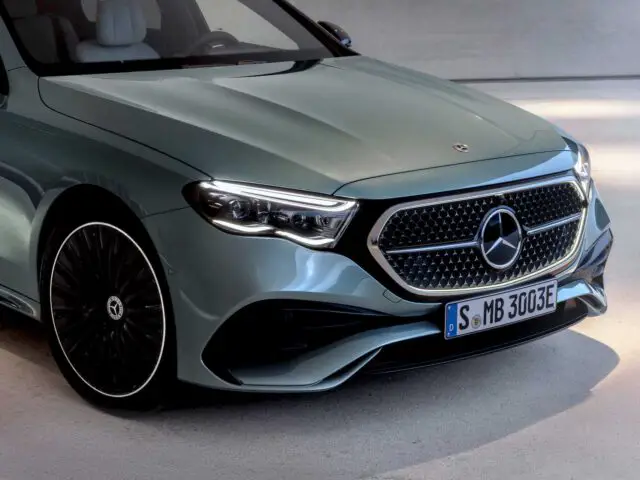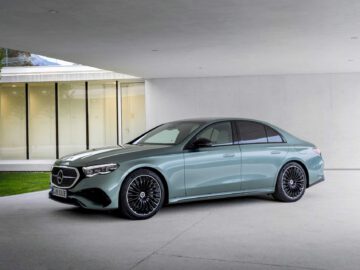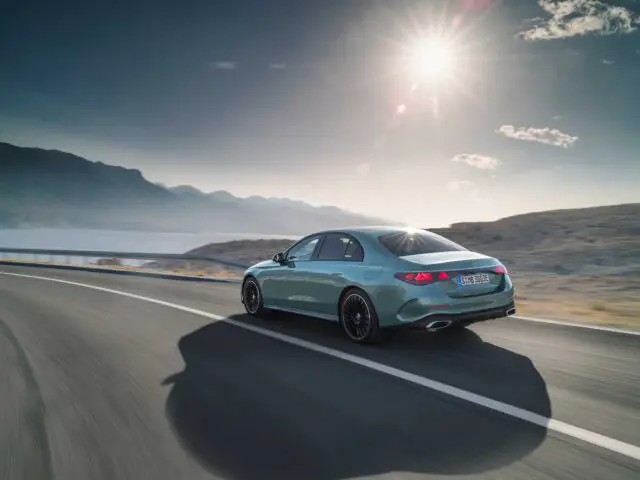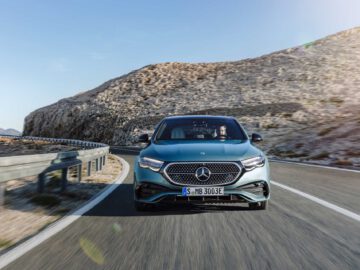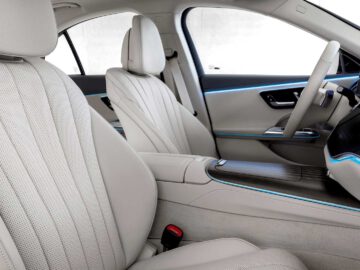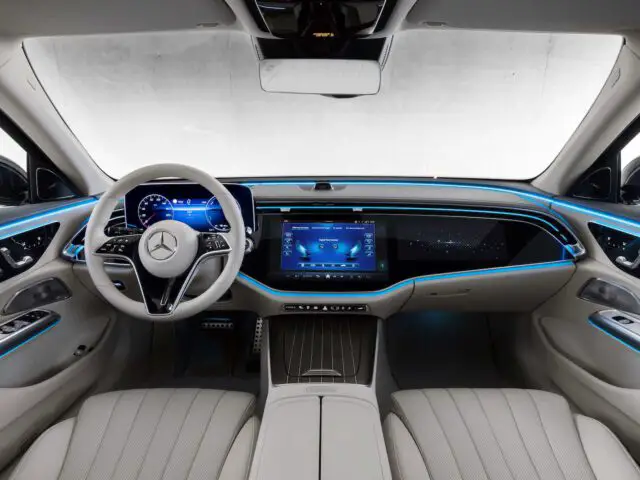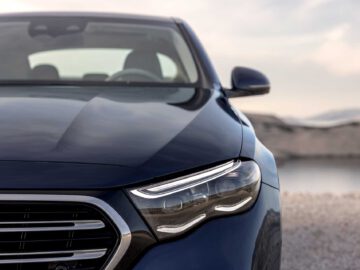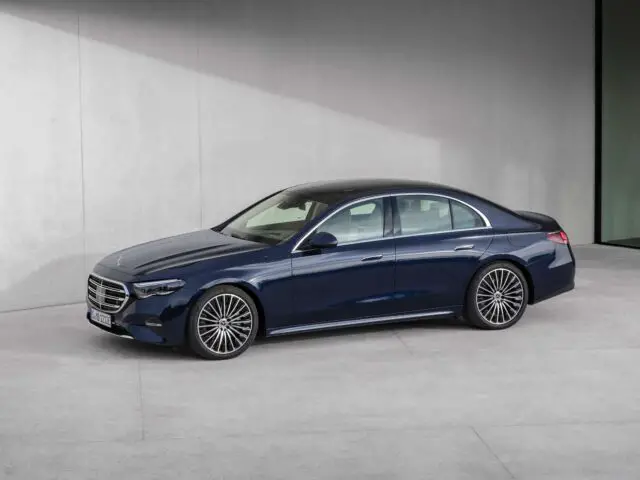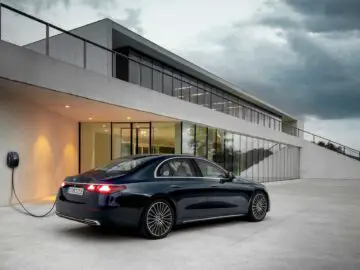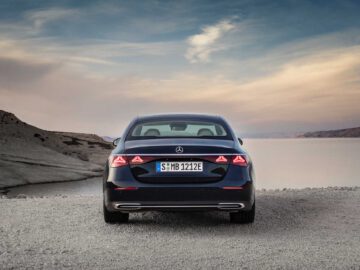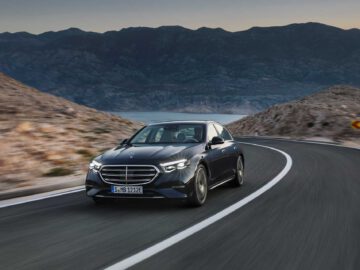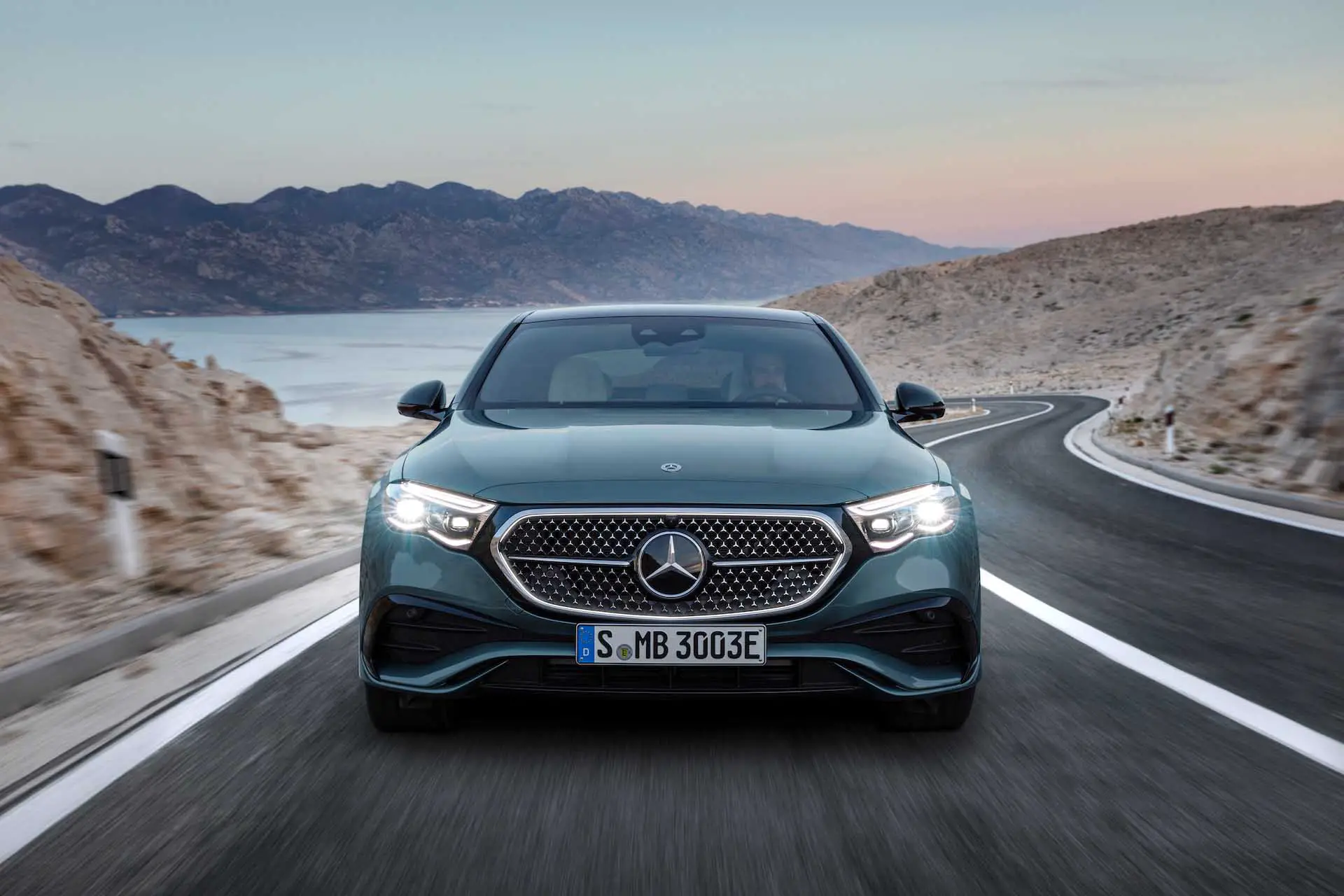New Mercedes-Benz E-Class has selfie and video camera and even TikTok!
Review of Mercedes-Benz E-Class
The Mercedes-Benz E-Class has been creating benchmarks in its segment of mid-range luxury limousines for more than 75 years. Mercedes-Benz has produced more than 16 million vehicles since 1946. The heritage of the E-Class goes back to the early days of the brand. At the beginning of the twentieth century, the companies from which Mercedes-Benz emerged were already marketing this type of model.
When operations resumed after World War II, the model 170 V (W136) originally introduced in 1936 went back into production. The Limousine followed in 1947 as Mercedes-Benz’s first postwar passenger car. The 1953 Model 180 (W120) with self-supporting “Pontoon” body introduced new technical and external features.
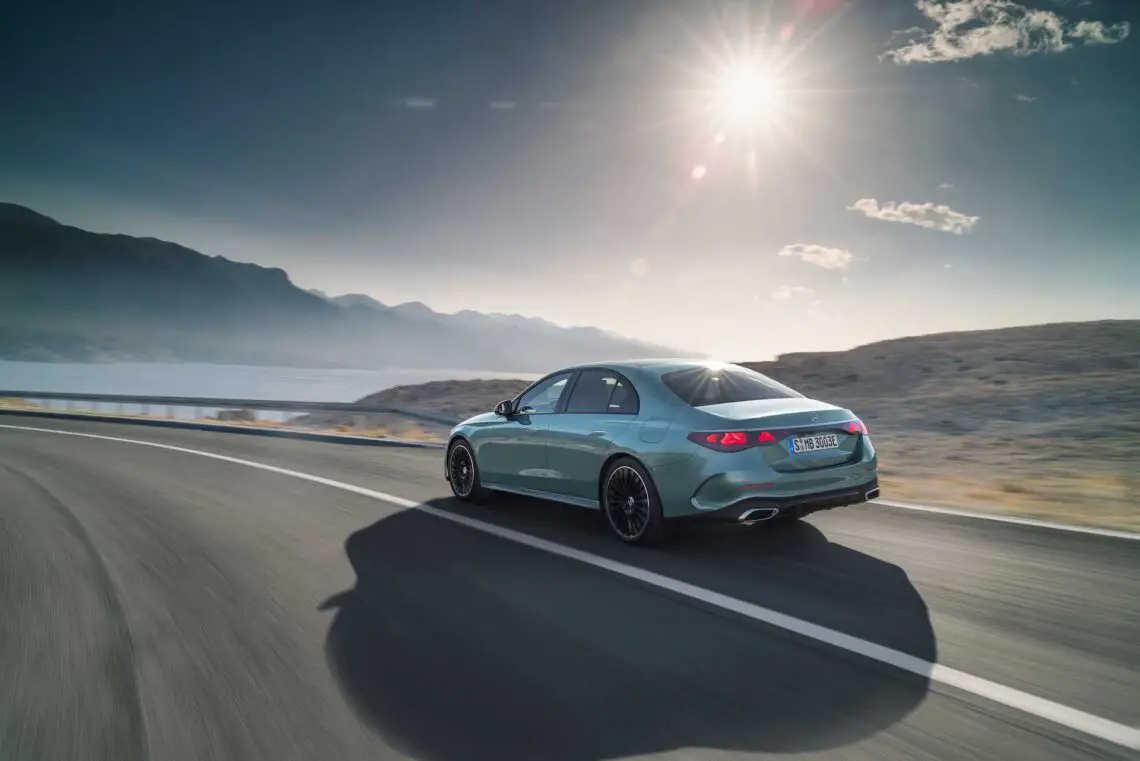
The name E-Class debuts
Four-cylinder versions of the “Heckflosse” series (W110) followed in 1961. In 1968, the upper mid-range “Strich 8” series (W114/115) marked the next big step. The subsequent 1976 W123 series proved even more successful. The W124 series produced from 1984 to 1995 first bore the E-Class name from mid-1993.
The W210 series launched in 1995 stood out with its front with double round light units and innovative technology. The E-Class W211 series entered the market in early 2002. The E-Class W212 Series (Limousine and Estate) and W207 Series (Cabriolet and Coupe) followed in 2009. The Mercedes-Benz E-Class W213 series debuted in 2016, and was also available as an All-Terrain for the first time from 2017. In addition, there are the Coupés and Cabriolets of the W238 series. And now – in 2023 – it’s time for the W214 generation of the Mercedes-Benz E-Class. What does this car have to offer?
Design Mercedes-Benz E-Class
The new E-Class has the proportions of a classic limousine: the short front overhang and long hood are followed by a far-reaching ‘greenhouse’. The cab-backward design is rounded out by the well-proportioned rear overhang. A Black Panel-like surface connects the grille to the headlights. This insert in high-gloss black is visually reminiscent of the Mercedes EQ models. The three-dimensionally designed grille looks progressive or classic, depending on the chosen trim line.
The new E-Class features powerful LED headlights as standard. Optional Digital Light is available without and with projection function. All headlight variants offer a distinctive day and night design. As a typical feature of the brand, the daytime running light units are shaped like an eyebrow. Powerdomes accentuate the hood.
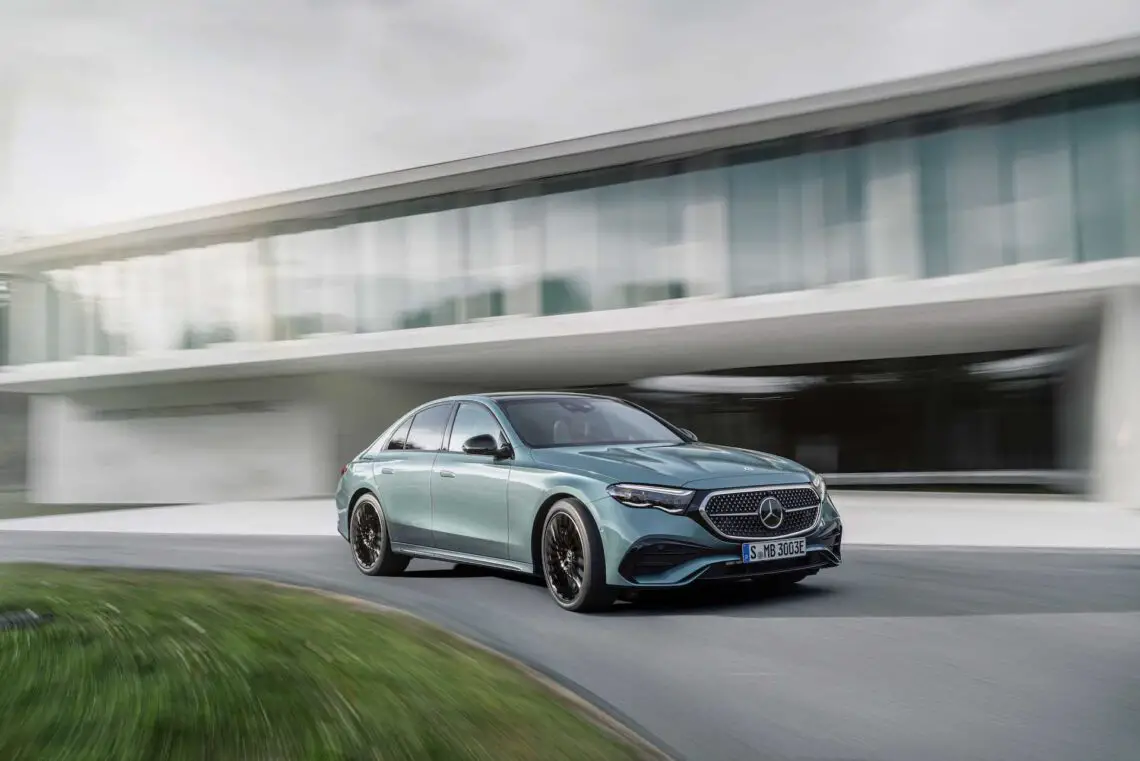
‘Cab-backward’ design
And profile, the harmonious proportions and distinctive “cab-backward” design stand out particularly well. The recessed door handles familiar from Mercedes-Benz luxury models are available as an option. The two distinct character lines on the flanks emphasize the sporty character. Highlights at the rear are the two-part LED taillights with a new contour and a special design: the star motif in both light units for a special day and night design.
MBUX Superscreen as a highlight of the interior design
The dashboard plays an important role in the interior digital experience. If the Mercedes-Benz E-Class is equipped with the optional front passenger display, the large glass surface of the MBUX Superscreen extends to the central display. The driver display is optically disconnected from this and is in the driver’s field of vision. Models without a front passenger display have a large trim piece that extends to the center. Visually detached from this, the central display appears to float above the concave surface of this trim piece.
The front of the dashboard is illuminated by the light band of active ambient lighting. This runs in a wide arc from the windshield, along the A-pillars into the doors. This creates a generous sense of space. An apparently free-floating control panel in the upper part of the door panels visually matches the appearance of the glass surfaces of the displays.
The center console is designed as a homogeneous unit and merges into the lower part of the dashboard in a straight line. At the front, a storage compartment with lid and cup holders are integrated into the three-dimensional shaped trim piece. There is a soft padded armrest in the rear part of the center console.
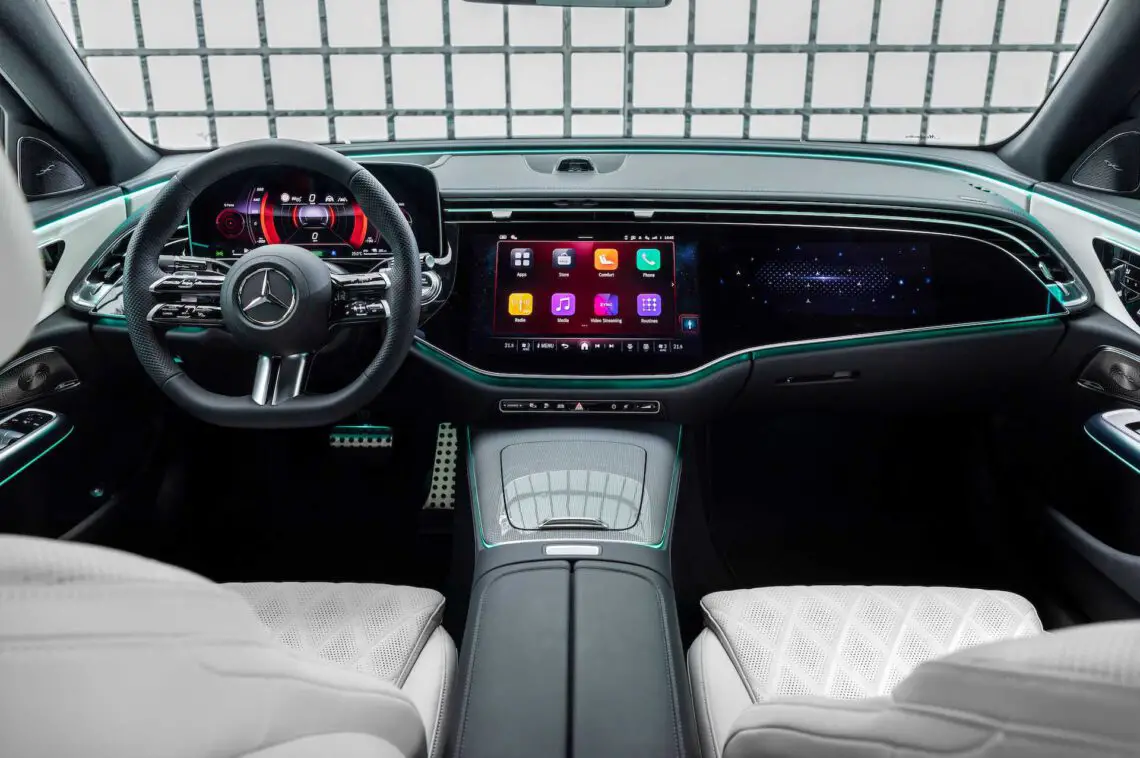
Middle section
The center section of the door merges seamlessly into the armrest with a concave shape. The front section is designed as a metal high-tech element. It serves as a hand and locking handle and contains the switches for the electric window controls. Another highlight is the free-floating control panel with door opener and seat function controls. The contours of the seat and back elegantly flow from inside to outside and, thanks to their layering, appear to float above the seat. Vertical indented lines follow the contours and widen upward.
Interior space increased
When it comes to interior space, the E-Class is one of the leading models in its segment. The driver has 5 mm more headroom than in the previous model. Rear passengers especially benefit from the 2 cm longer wheelbase: knee space and maximum legroom increased by 10 and 17 mm, respectively. The rear elbow width has increased even more: it is now 1,519 mm. This is an increase of 25 mm and almost at the level of the S-Class. The boot volume has increased to 540 liters.
Half of the engine variants are plug-in hybrids
Half of all models are fourth-generation plug-in hybrids. The internal combustion engines are four- and six-cylinders from Mercedes-Benz’s current modular engine family, called FAME (Family of Modular Engines). Thus, the engine range plays an important role in the flexibility of the international production network, with electrification tailored to needs. In addition to turbocharging, both the diesel and gasoline engines have intelligent support from an integrated starter generator (ISG). So they are mild hybrids. Thanks to a new battery, the power of the electric motor has been increased from 15 to 17 kW and boost torque to 205 Nm.
The model range when introduced in Europe (internal combustion engines/mild hybrids):
| E 200 | E 220 d | E 220 d 4MATIC | |
| Displacement cc | 1.999 | 1.993 | 1.993 |
| Max. power kW/hp | 150/204 | 145/197 | 145/197 |
| At rpm | 5.800 | 3.600 | 3.600 |
| Extra power (boost) kW/hp | 17/23 | 17/23 | 17/23 |
| Max. torque Nm | 320 | 440 | 440 |
| At rpm | 1.800-4000 | 1.800-2.800 | 1.800-2.800 |
| Extra torque (boost) Nm | 205 | 205 | 205 |
| Fuel consumption combined, WLTP | 7,3-6,4 | 5,5-4,8 | 5,7-4,9 |
| CO2 emissions combined, WLTP | 166-144 | 144-125 | 149-130 |
| Acceleration 0-100 km/h. | 7,5 | 7,6 | 7,8 |
| Top speed km/h | 240 | 238 | 234 |
More plug-in hybrids to follow
Mercedes-Benz will offer no less than three fourth-generation plug-in hybrids starting with the introduction of the new E-Class. With an electric power of 95 kW (129 hp) and an all-electric range of up to over 100 km (WLTP), they can drive all-electric in many cases and on many days, without the use of the internal combustion engine. More plug-in hybrids with diesel engines will follow.
The model range when introduced in Europe (plug-in hybrids):
| E 300 e (E 300 e 4MATIC) | E 400 e 4MATIC | |
| Displacement cc | 1.999 | 1.999 |
| Rated power, internal combustion engine kW/hp. | 150/204 | 185/252 |
| Rated torque, internal combustion engine Nm | 320 | 400 |
| Rated power, electric motor kW/hp. | 95/129 | 95/129 |
| Rated torque, electric motor Nm | 440 | 440 |
| System power kW | 230 | 280 |
| System torque Nm | 550 | 650 |
| Energy content of the HV battery kWh | 25,4 | 25,4 |
| Top speed km/h | 236 (234) | 250 |
| Acceleration 0-100 km/h. | 6,4 (6,5) | 5,3 |
| Weighted fuel consumption combined (WLTP). | 0,8 – 0,5 (0,9-0,6) | 0,9 – 0,6 |
| Weighted power combined (WLTP). | 20,7 – 18,4 (21,6-19,2) | 21,6 – 19,2 |
| WeightedCO2 emissions combined (WLTP). | 18 – 12 (20-14) | 20 – 14 |
| Electric range (EAER, WLTP). | 99-118 (95-111) | 95 – 111 |
AIRMATIC and rear axle steering optionally available
The smooth handling of the new E-Class is largely due to the precise guidance of the front wheels by four wishbones per wheel. At the rear axle, an optimized and independent multilink rear suspension with five wishbones ensures excellent wheel control and equally convincing straight-line stability. In both axles, the springs and dampers are combined in a single strut and are not involved in wheel guidance, so the suspension responds with corresponding sensitivity. The front subframe and rear axle carrier decouple the suspension and body, which prevents the transmission of vibrations and noises. The mild hybrids come standard with a steel-spring suspension and the selective damping system AGILITY CONTROL. The suspension is also 15 mm lower than that of the plug-in hybrids.
Technology Package
The new E-Class is optionally available with the technology package. This includes AIRMATIC air suspension all round with infinitely adjustable damping ADS+ and rear axle steering. The AIRMATIC suspension with air suspension and adaptive ADS+ dampers is very responsive. Level control is another feature of AIRMATIC. That keeps ground clearance constant regardless of the car’s load, but also makes adjustments as needed.
The new E-Class is optionally available with the Technology Package. This includes AIRMATIC air suspension with ADS+ continuously variable damping and rear axle steering. The AIRMATIC with air springs and adaptive ADS+ dampers responds very sensitively. Level control is another feature of AIRMATIC. It keeps the ground clearance constant regardless of the vehicle load, but also adjusts it if necessary.
With the optional rear axle steering and the corresponding, more direct steering ratio on the front axle, the new E-Class responds particularly agile and at the same time stable. The steering angle at the rear axle is 4.5°. This reduces the turning radius to 90 cm.
Entertainment Experience
Music, games and streaming content can be experienced in the E-Class with almost all the senses. Thanks to digital innovations in the interior, the E-Class is now more intelligent, achieving a new dimension of personalization and interaction. At the same time, the electronics architecture is more software-driven and less hardware-driven.
The computational functions of domains that were previously separate take place in a single processor. The displays and the MBUX infotainment system thus share a new, very powerful central on-board computer. This link improves performance because data can be transmitted significantly faster.
The new E-Class gets the entertainment package (MBUX entertainment plus. It includes Mercedes me connect services and a data package from a third-party provider. Depending on the country, a communication module is used with 5G as the transmission technology. The cell phone standard 5G enables much higher data rates than LTE/UMTS.

Digital vehicle key now available for iPhone and Apple Watch
With the digital vehicle key, the E-Class can be easily started and locked by the driver with an appropriate device. Key sharing is also possible: through various digital channels, family members or friends can be invited to use the E-Class. In doing so, the owner of the vehicle can grant various rights, granting only access to the vehicle or also permission to drive. The vehicle can recognize multiple users simultaneously and the digital vehicle key can be shared by up to 16 people. In countries where Mercedes me connect services are available, preparation for the digital vehicle key is part of the KEYLESS GO convenience package. This equipment combination is available in the new E-Class starting with the premium package.
Music becomes visible: sound visualization
With the new active ambient lighting with sound visualization, occupants of the new E-Class can experience music with three senses: music and sounds from movies or apps can be listened to (optionally with Dolby Atmos technology), felt (through sound-resonant transducers of the optional Burmester 4D surround sound system) and now also “seen. The visualization takes place on the light band of the active ambient lighting (option). This runs through the entire vehicle for the first time in the E-Class. For example, rapid sequences of beats can cause rapid light changes, while smooth rhythms create softly blending light moods. The entertainment experience for the front passenger is impressive. The optional front passenger display allows the front passenger to view dynamic content, such as TV or video streaming, even when the driver behind the wheel is also looking in this direction. In fact, the display is switchable. The advanced, camera-based privacy feature reduces its brightness and thus the risk of driver distraction.
New third-party apps plus selfie and video camera
Mercedes-Benz software experts have developed a new compatibility layer that allows the installation of third-party apps. The following apps will be available via a single user interface on the central display when the E-Class is introduced: the entertainment platform “TikTok,” the game “Angry Birds,” the collaboration app “Webex,” the office app “Zoom” and the browser “Vivaldi. In addition, the entertainment portal ZYNC (optional) offers video streaming, on-demand content, interactive experiences, local video programming, sports, news, games and more on the center display and front passenger display.
Selfie and video camera
Also new is a selfie and video camera (part of the optional MBUX Superscreen) on top of the dashboard. When the vehicle is stationary, a video image allows the driver to participate in online conferences via “Webex,” for example, and take personal photos and videos. MBUX also offers greater ease of operation. With the “Just Talk” feature, intelligent voice control can now be activated even without the keyword “Hey Mercedes. When the function is activated, a red microphone symbol appears in the display. This indicates that the vehicle is ready and waiting for commands.
Energizing Comfort
Soothing sounds, mobilizing massage, activating light – Mercedes-Benz offers a comprehensive wellness program with the various Energizing Comfort programs and the individual recommendations of the Energizing Coach. A new feature debuts in the new E-Class: the Energizing Comfort program to prevent car sickness helps passengers who suffer from it relieve the symptoms. A biofeedback feature is planned for the Energizing Coach in the medium term. This one can reduce feelings of stress with breathing exercises.
Digital Vent Control
Digital Vent Control, part of the Thermotronic automatic air conditioning system (option), enhances the comfort experience. It automatically adjusts the front air outlets to a desired ventilation scenario. For example, this can be done by chair through the user profile. However, the air outlets can also be adjusted by hand as usual.
Driver assistance systems
Among the driving assistance systems with which the E-Class comes standard are Attention Assist, Active Brake Assist, Active Track Assist, Parking Package with Rear View Camera and Speed Limit Assist. The status and activity of the driver assistance systems are displayed as a full-screen image in the assistance mode of the driver display.
Combined with the camera, Attention Assist now also provides a warning via the 3D driver display (optional) if the driver’s eyes are not focused on the road for a few seconds. Attention Assist can detect a distraction and alert the driver visibly and audibly. If the driver is still not paying attention to the traffic situation, a second warning and a sustained warning tone follows. If the driver still does not respond to the warning, the system can initiate an emergency stop via the active emergency stop assistant.
The driving assistance package plus is also offered as an option, for example as part of the premium package. The package includes active steering assist, which helps maintain lane keeping. In addition to highways, the E-Class can now automatically accelerate after coming to a stop in city traffic and on county roads. Also new: if the active steering assistant becomes unavailable because lane markings are not clearly visible, it signals this to the driver with a vibrating steering wheel.
Various airbags and safety
The safety concept of the E-Class is based on a body with a particularly rigid passenger cell and specifically deformable crash structures. The safety systems, for example seat belts and airbags, are specifically tailored to this. In the event of an accident, they can be activated so that their protective effect for the occupants is adapted to the situation.
In addition to airbags for the driver and front passenger, a kneebag on the driver’s side is also standard. This can protect the legs from contact with the steering column or dashboard in a severe frontal impact. Standard windowbags can reduce the risk of head impact with the side window or penetrating objects. In a severe frontal collision, the windowbag on the side of impact extends from the A to C pillar like a curtain over the front and rear side windows. If rollover is detected, the windowbags on both sides can be activated. In addition to the head protection system, the sidebags can also cover the chest in the event of a severe side impact – even in the outboard rear seats (optional).
Depending on the country in which it is sold, the new E-Class is also equipped with a center airbag. Pyrotechnic belt pretensioners and belt force limiters are standard on all outboard seats.
Resource-saving materials
Many parts of the E-Class are made in part from resource-saving materials (recyclates and renewable raw materials). The base seats of the E-Class use upholstery made of undyed alpaca wool combined with a recycled material. Certified recycled raw materials are used for the first time in the foam of the chairs according to the “mass balance approach,” and their properties do not differ from those of raw materials produced from crude oil. In this way, the need for fossil raw materials can be reduced while maintaining product quality.
Factory in Sindelfingen
Since 2022, Mercedes-Benz has been producing with a neutralCO2 balance in all its own plants worldwide. The externally generated electricity is exclusively from renewable energy sources and thusCO2-free. In addition, the manufacturer plans to increase renewable energy generation at its sites. Investments are therefore being made to further expand the use of photovoltaics at the entire Sindelfingen site by the end of 2024. The focus at the Sindelfingen site is also on continuously reducing water consumption and the amount of waste produced.
